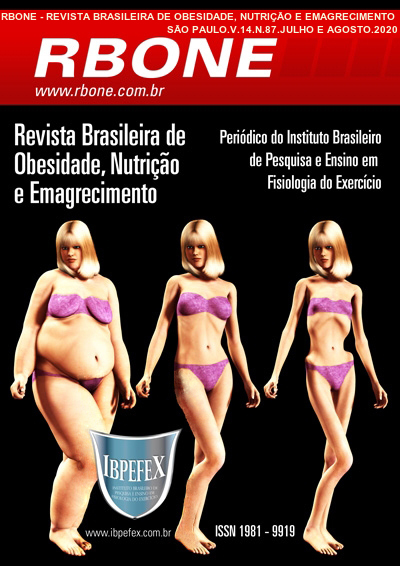Signs and symptoms of food hypersensitivities between vegetarian individuals vs. onÃvoros
Abstract
Objective: To compare clinical signs and symptoms related to feeding between omnivorous and vegetarian adults. Methods: The present work was developed based on a descriptive, quantitative and transversal research. The research population was composed of two groups: omnivores and vegetarians. The sample selection was intentional non-probabilistic, with a total of 100 individuals. The Metabolic Tracking Questionnaire (QRM), Bristol Scale and Constipation Questionnaire were used to compare and relate the type of diet with the signs and symptoms of food hypersensitivity. Results: When comparing the QRM between the groups, it can be observed that the percentage of individuals considered healthy was 20.9% in the vegetarian group and 9.1% in the omnivorous group. In addition, 16.4% of vegetarians had low hypersensitivity, while no omnivorous individual fit this classification. Another positive result found in favor of vegetarianism was that 66.7% of omnivores showed moderate hypersensitivity and only 34% of vegetarians were classified as moderate. For all these comparisons, there was a significance of p = 0.003 between the groups. On the other hand, there was no significant difference between vegans and omnivores inherent to the Bristol Scale. Conclusion: Vegetarian patients, compared to omnivorous patients, showed more favorable clinical responses regarding signs and symptoms of food hypersensitivity. However, further scientific investigation of vegetarianism in the intestinal health scenario is interesting, whose new controlled clinical trials are important especially in the investigation of biomarkers to complement the findings.
References
-Alves, J.G. Constipação intestinal. Jornal brasileiro de Medicina. Vol. 268. Num. 2. 2013.
-Appleby, P.N.; Key, T.J. The long-term health of vegetarians and vegans. Proceedings of Nutrition Society. Vol. 75. Num 3. p. 287-293. 2016.
-Baker, J. L.; Olsen, L. W.; Sorensen, T. I. Childhood Body-Mass Index and the Risk of Coronary Heart Disease in Adulthood. The New England Journal of Medicine. Vol. 357. Num. 23. p. 2329-2337. 2007.
-Berrougui, H.; Ikhlef, S.; Khalil, A. Extra Virgin Olive Oil Polyphenols Promote Cholesterol Efflux and Improve HDL Functionality. Evidence-Based Complementary and Alternative Medicine. Vol. 2015. p.208062. 2015.
-Beto, J.A. The Role of Calcium in Human Aging. Clinical Nutrition Research. Vol. 4. Num. 1. p. 1-8. 2015.
-Bridi, A.M. Consumo de carne bovina e saúde humana: convergências e divergências. 2012. Disponível em: <http://www.uel.br/grupo-pesquisa/gpac/pages/arquivos/consumo%20de%20carne%20revisado%20II%20livro%20ronaldo.pdf >.
-Centro Brasileiro de Nutrição Funcional. Questionário de rastreamento metabólico. 2014. Disponível em:<https://pt.scribd.com/doc/135572702/Questionario-de-Rastreamento-metabolico>.
-Galdino, J.J. Questionário de rastreamento metabólico voltado a disbiose intestinal em profissionais de Enfermagem. Revista Brasileira de Obesidade, Nutrição e Emagrecimento. São Paulo. Vol. 10. Num. 57. p. 117-122. 2016.
-Green, R.; Allen, L.H.; Bjørke-Monsen, A.L.; Brito, A. Vitamin B12 deficiency. Nature Reviews Disease Primers. Num. 3. Vol. 17040. 2017.
-IBOPE. Crescimento histórico no número de vegetarianos no Brasil. Sociedade Vegetariana Brasileira. 2018. Disponível em: <https://www.svb.org.br/2469-pesquisa-do-ibope-aponta-crescimento-historico-no-numero-de-vegetarianos-no-brasil.
-Iguacel, I.; Miguel-Berges, M.L; Gómez-Bruton, A.; Moreno, L.A.; et al. Veganism, vegetarianism, bone mineral density, and fracture risk: a systematic review and meta-analysis. Nutrition Reviews. Vol. 77. Num. 1. p. 1-18. 2019.
-Losasso,C.; Eckert,E.M.; Mastrorilli,E.; Villiger J.; et al. Assessing the Influence of Vegan, Vegetarian and Omnivore Oriented Westernized Dietary Styles on Human Gut Microbiota: A Cross Sectional Study. Frontiers in Microbiology. Vol. 9. 2018.
-Martinez, A. P.; Azevedo, G. R. Tradução, adaptação cultural e validação da Bristol Stool Form Scale para a população brasileira. Rev. Latino-Am. Enfermagem, Ribeirão Preto. Vol. 20. Num. 3. p. 583-589. 2012.
-Mathieu, S.; Dorard, G. Vegetarianism and veganism lifestyle: Motivation and psychological dimensions associated with selective diet. La Presse Médicale. Vol. 45. Num. 9. p. 726-733. 2016.
-Obeid, R.; Heil, S.G.; Verhoeven, M.M.A.; van den Heuvel, E.G.H.M. Vitamin B12 Intake From Animal Foods, Biomarkers, and Health Aspects. Frontiers in Nutrition. Vol. 6. Num. 93. 2019.
-Santos, H.O. The Need for Sex Hormone Analysis in Addition to Long-Term Follow-Up of Phytosterol Supplementation. Arquivos Brasileiros de Cardiologia. Num. 111. Vol. 2. 2018. p. 228-229. 2018a.
-Santos, H.O.; Bueno, A.A.; Mota, J.P. The effect of artichoke on lipid profile: A review of possible mechanisms of action. Pharmacological Research. Vol. 137. p. 170-178. 2018b.
-Sharma, S.; Sharma, R.K.; Parashar. Comparison of the nutritional status and outcome in thermal burn patients receiving vegetarian and non-vegetarian diets. Indian J Plast Surg. Vol. 47. Num. 2. 2014.
-The American Dietetic Association. Position of the American Dietetic Association and Dietitians of Canada: Vegetarian diets. J Am Diet Assoc. Vol. 103. Num. 6. 2003.
-Weiss, G. A.; Hennet, T. Mechanisms and consequences of intestinal dysbiosis. Zurich Open Repository and Archive. Vol. 74. Num. 1. p. 6. 2017.
-Zimmermann, L.C.; Cezar, T.M. Prevalência de sinais e sintomas avaliados em um grupo de emagrecimento de um centro universitário do oeste do Paraná. Fag Journal of Health. 2019. Edição Especial. p. 20.
Copyright (c) 2020 Beatriz Dagostin, Maria Luiza dos Santos Guellere, David Bastista Gesuino, Kristian Madeira, Marco Antônio da Silva, Heitor Oliveira Santos, Thais Fernandes Luciano

This work is licensed under a Creative Commons Attribution-NonCommercial 4.0 International License.
Authors who publish in this journal agree to the following terms:
- Authors retain the copyright and grant the journal the right of first publication, with work simultaneously licensed under the Creative Commons Attribution License BY-NC which allows the sharing of the work with acknowledgment of the authorship of the work and initial publication in this journal.
- Authors are authorized to enter into additional contracts separately for non-exclusive distribution of the version of the work published in this journal (eg, publishing in institutional repository or book chapter), with acknowledgment of authorship and initial publication in this journal.
- Authors are allowed and encouraged to post and distribute their work online (eg, in institutional repositories or on their personal page) at any point before or during the editorial process, as this can bring about productive change as well as increase impact and impact. citation of published work (See The Effect of Free Access).






